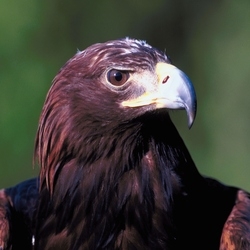 With the recent federal prosecution of Duke Renewable Energy for killing 163 birds, including 14 golden eagles, there is renewed interest in just how many birds wind turbines kill.
With the recent federal prosecution of Duke Renewable Energy for killing 163 birds, including 14 golden eagles, there is renewed interest in just how many birds wind turbines kill.
In 2013, while the Associated Press ran stories about the Duke case and the U.S. Fish and Wildlife Service (FWS) was conducting investigations of 17 other wind energy facilities, three bird fatality estimates were published for the U.S. and Canada. However, only one captured media attention.
The two that did not appear in the news appear to be the most credible analyses to date.
This is, in part, because of the immense database and large number of studies the authors relied on, and the fact that the authors were from respected wildlife agencies and scientific institutions.
Scott Loss, Peter Marra (both from the Smithsonian Institution) and Tom Will (FWS) reported in the journal Biological Conservation that about 234,000 birds are killed per year at the 44,000 wind turbines operating in the U.S.
Their analysis was based on information from 68 U.S. studies and included the numbers of carcasses found, an adjustment for carcass persistence (scavenging), searcher efficiency and carcasses that fell beyond search areas. Their comprehensive analysis translated to an average of about 5 to 6 fatalities per turbine per year.
In the other study, biologists from Environment Canada (Ryan Zimmerling, Charles Francis) and two consulting firms (Stantec [Andrea Pomeroy] and LGL [Marc d'Entremont]) reported that 23,300 birds were killed annually by 2,955 turbines in Canada. Their results were published in Conservation and Ecology.
Their fatality estimate was based on data from studies at 50 wind projects across Canada. Their estimate also relied on the numbers of carcasses found and adjustments for carcass persistence, searcher efficiency, and carcasses that may have fallen beyond the 50 m search areas around turbines. Their data showed that wind turbines in Canada kill about 8.2 birds per turbine per year.
Although there was a difference of about 2 to 3 birds per turbine per year between the U.S. and Canadian estimates, this difference is quite small in absolute terms and may be explained, in part, by the different statistical methods each research group used to calculate their fatality estimates.
Overall, the estimates were in the same ballpark, and the two research groups arrived at similar estimates despite different methodological approaches.
The estimate that captured media attention was considerably higher. Shawn Smallwood, a consultant from California, estimates in the Wildlife Society Bulletin that about 573,000 birds were killed per year in the U.S. That is equivalent to roughly 20 birds killed per turbine per year, or 2.4 to nearly four times greater than the above estimates.
This is surprising because the maximum fatality rates for a given wind plant from the more than 100 fatality studies that informed the analyses of Loss et al. and Zimmerling et al. were roughly 15 birds per turbine per year, which is much lower than the mean of about 20 per turbine that Smallwood calculated.
A closer examination of Smallwood's analysis is a real eye-opener. At the Noble Ellenburg project in upstate New York, my firm concluded that the fatality rate was about two to 5.7 birds per turbine per year, which, using Smallwood's methodology, would be re-calculated at 41.8 per turbine – an enormous difference that makes you wonder.
There are additional discrepancies between the original researchers' estimates at different wind projects across the continent and Smallwood's new estimates for those facilities.
What Smallwood appears to be saying is that the research of dozens of respected university professors, state and federal wildlife agency biologists, and consulting biologists is flawed. This seems doubtful, given the consistency of fatality estimates and their replication by different research groups, not to mention the high level of scrutiny of those results by academic and agency scientists. The groups also used somewhat different methodologies to arrive at their estimates, which makes their overall results even more robust and reliable. If any estimate merits further scrutiny, it is Smallwood's.
Using the results of Loss et al. and Zimmerling et al., we can now make reliable comparisons of wind turbine fatalities to other anthropogenically-caused fatalities.
For example, publicly owned communication towers in Michigan, which also have been well studied, kill 100+ birds per tower each year. This is 12 to nearly 20 times more per structure than wind turbines. Overall, in the U.S. and Canada, communication towers kill an estimated 6.8 million birds per year, which means that in aggregate, communication towers kill more than 25 times more birds than do all wind turbines!
The results of Loss et al. and Zimmerling et al. are good news for the wind industry. Though largely ignored by the media, they are the most credible and robust fatality estimates to date. Not only have bird fatalities proven relatively minor in number, but the lead wildlife agencies in Canada and the U.S. seem to be in agreement over fatality rates.
Most importantly, these studies need to be disseminated both within and outside of the wind industry, including government wildlife and environmental agencies, nonprofit conservation organizations, and the press.
Paul Kerlinger, Ph.D., is senior scientist and principal at Curry & Kerlinger LLC, a consulting firm specializing in bird and bat issues. He can be reached at (609) 884-2842 or pkerlinger@comcast.net.




At a Christmas party I once suggested to the CEO of Syncrude that they surround the tailings ponds with windmills. Then they would shred the birds before they could even land on the ponds and the environmentalists would be happy.